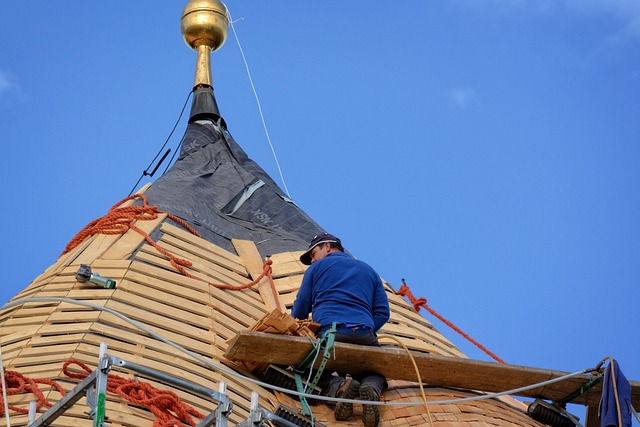Flat Roof Materials:
Which Is a Better Roofing System – TPO, EPDM, or PVC?
Why Knowing Matters
If you are in the market for a new roof, then you probably realized very quickly that there are a lot of choices to make. With so many choices, we sometimes leave the decision to our roofing contractor; we just let him tell us what we should do. If you are blessed with the financial where-with-all to construct your own building, then maybe you just let your architect make the call. Either way may be ‘good enough,’ but it only makes sense to educate yourself about the matter. At the very least, arming yourself with this knowledge – even a cursory amount – will give you the opportunity to ask pertinent questions. Then you can decide if the answers to those informed questions satisfy you. You are potentially spending a lot of money on your roof. Making sure you’re getting the most out of your hard-earned dollars is just a sensible thing to do.
Before getting into our article, bear in mind that the best product in the world will still fail if improperly installed. Success is almost always a collaboration of (1) a quality product installed by a (2) quality contactor. If you remove one from that equation it is generally unreasonable to expect that you will get what you paid for. Remove both from the equation? Well, I’m sure you can do the math.
In this newsletter article, it is my aim to answer the following questions in simple, straightforward language:
I’ll also provide you with my expert opinion about the subject and give you another possible solution to your roofing problems. So, let’s get to it…
What Do All Those Letters Mean?
The term TPO stands for Thermoplastic Polyolefin. Believe it or not, TPO is actually in a broad family of rubber roofing materials. TPO is a blend of polypropylene and ethylene-propylene rubber.
EPDM stands for Ethylene Propylene Diene Monomer. It is a synthetic rubber derived from oil and natural gas (ethylene propylene). When the ethylene propylene is combined with diene (an unsaturated hydrocarbon alkene containing two carbon-to-carbon double bonds), the flexible EPDM membrane is born.
The term PVC stands for Polyvinyl Chloride. PVC materials are produced by a chemical reaction, known as polymerization. (Polymers are a natural or synthetic compound that consist of large molecules made of many chemically-bonded smaller molecules, known as monomers.) PVC is produced by the gaseous reaction of ethylene with oxygen and hydrochloric acid.
Now if that wasn’t tedious and boring enough, there are several other roofing acronyms out there. For example, there’s CSPE, which stands for Chlorosulfonated Polyethylene; PIP for Polyisobutylene; and KEE for Ketone Ethylene Ester. Holy Cow, Batman! Do you really need to know all this stuff? No. But it is good to at least know that these letters mean something, that there is a chemically-designed manufacturing process to these different roofing membranes. I’m only covering TPO, PVC, and EPDM, because frankly, they are the most common used in the roofing industry today. They are probably what you are going to encounter most often.
With all the minutia out of the way, what you really need to know is ‘what will work best for my roof?’ Let’s tackle that next by trying to differentiate these roofing products in practical terms.
The Basic Differences
TPO
TPO is probably the most widely used roofing product in the market today for two very good reasons: (1) it’s relatively cheap and (2) because it’s white. Cheap doesn’t always make something better, though. In fact, that is seldom the case. And being white isn’t really anything special, not anymore; even EPDM, which is a black membrane, is also available with a white laminated top. So is there anything about TPO that makes it a viable option for your roof. Absolutely! …
Well, not really. I was just kidding. Over the years TPO manufacturers have revised and re-revised their proprietary formulations simply to get it to work. TPO – as it is currently formulated – does not have a long track record. That track record is also not very compelling. TPO is known to shrink and pull away from seams and curbs. That was one of many reasons for the constant reformulations of the product in the first place. Unfortunately, that problem hasn’t completely gone away yet.
Furthermore, there was an interesting article that appeared in Perspectives magazine, Volume 66, in May 2010 (www.benchmark-inc.com). The roofing consultants of Benchmark, Inc. did an extensive hands-on study of TPO. Here’s what author Jeff Evans, RRC, had to say:
“Our investigations of our clients’ roofs continue to identify issues with some TPO membranes: splitting and crazing along rows of fasteners, accelerated aging along walkpads, polymer erosion to the point of exposing scrim reinforcement; enough issues for us to have concerns.”
That wasn’t even the funniest part. Yes, I said “funny.” When most people decide on a TPO roof, they often do so based on price alone. But a cheap roof is often … well, a cheap roof.
C’mon, man? You’re kidding me, right? TPO is still not formulated properly to be able to handle sunlight? Hmmm. Not a particularly good quality for a roof, wouldn’t you say? See why it’s so funny? At the time of publishing this article, the advisory could still be found online at
https://www.mrca.org/i4a/headlines/headlinedetails.cfm?id=1060.
For fairness’ sake, Firestone (manufacturers of EPDM and TPO membranes) responded to the MRCA advisory as follows:
“Not all TPO products are the same. Other TPO roofing manufacturers may alter their formulations and experience issues with high solar and temperature exposure. This is not the case with Firestone.”
Benchmark responded to that response by stating the following:
“Firestone’s comment that “not all TPO products are the same,” and their statement that other TPO manufacturers might have “issues with high solar and temperature exposure” are at the heart of the issue for Benchmark. Clearly, there have been issues with TPO formulations. Who has it right? Does anyone?”
Does anyone? Good question. That article contained a lot more information about problems with TPO membranes; problems that have been around since its inception and continue to be addressed and re-addressed. So just because TPO is cheap and white doesn’t mean it would be a good option for you. But I’ll leave that for you to decide. I’m just here to present the information.
The TPO membrane can be mechanically-attached (screwed) or fully-adhered (glued). (See Ballast Footnote) When it comes to the seams and the detail work, the membrane can be glued or heat-welded. The materials of the TPO membrane, however, make it a difficult material to heat-weld correctly. Though some TPO membranes have at least some pliability, others are nearly board-like in their rigidity.
A key component of a TPO membrane is its laminated nature. The material that you see on top is not the same material you see on the bottom. Often the top is white and the bottom is gray. This is because it is not the same material through-and-through. A wearing surface is provided on top and filler material is provided on the bottom. (It’s kind of like a hot dog – there’s probably something good in there somewhere, but I wouldn’t want to eat it.) Usually when you laminate something, it serves to create an added point of weakness. Fiber reinforcement can be added to a TPO membrane that does make it stronger and more durable. But that sometimes comes at the expense of added rigidity, which makes it harder to work with during the installation process.
TPO is a roll good system, meaning that it comes in relatively small rolls. The rolls average about 8 feet wide by 50 or 100 feet long. Other sizes are available, but they are still relatively small. This means there are a tremendous amount of seams created during the installation process. Seams are the weakest part of any roofing system. The more seams that have to be field-welded or glued allows for more human error. More human error means a generally weakened roofing product throughout.
The primary thickness of a TPO membrane is 45-mils with 60-mils fast becoming the standard. There are also 72-, 80-, and 90-mil membranes available. (A mil is 0.001 of an inch; 45 mils equal 0.045 inches). Why such a wide range? Since some believe that “thicker is better,” manufacturers often cater to that belief. But thicker is not always better, especially when the thickness is designed to mask the inherent weakness of the product. It’s like putting perfume on a pig. It may “smell” better, but it’s still just a pig. I’m not saying that TPO is a pig; that would be silly. I like pigs. But let me ask you, which is of higher quality: an 8-track tape, a vinyl record, or a CD? Obviously a CD is the product with the highest quality, exponentially so. But it is also significantly thinner/smaller than its predecessors. As technology improves – as engineering of a product becomes more refined – you typically get better quality at a smaller size. (Has anyone seen how thin big screen TVs are now? With the thicker-is-better mentality, we should all be buying the 4-foot deep LCD TVs.) The fact is, with some things thinner is better and often indicates higher quality. Furthermore, making a roofing membrane thicker also makes it heavier, which makes it more expensive to ship. They are also much harder to properly seam in the field.
The good thing about TPO is that it does have a reasonably high resistance to animal fats, some hydrocarbon and vegetable oils, and microbial growth. And as I mentioned before, it is cheap. It is typically the cheapest of the three main roofing membranes mentioned in this article. Don’t get me wrong, it has its place. But you get what you pay for, and I’m not here to promote one over the other. It is what it is. But millions of SF of TPO membrane are already installed with millions more to come. This product is not going away so you need to be able to identify if quality, durability, warranty coverage, or cost is your main concern.
(IMPORTANT NOTE: Since there are so many manufacturers offering so many variations on the theme, it is critical that you compare roofing products correctly. Not all roofing products are exactly the same from manufacturer to manufacturer. For example, TPO sold by one manufacturer might be of a different quality than TPO sold by another manufacturer. Not all TPOs are the same when compared against each other. But they are enough the same to compare against other types of roofing products; i.e., EPDM or PVC. That, in fact, is the point of this newsletter; helping you see the differences between differenttypes of roofing systems.
You might settle on a PVC roofing system, thinking that it has the qualities you need for your next roofing system, making it a bettertype of roofing system than either TPO or EPDM. But at that point, you’d only be half done with your comparison shopping. You’ll next need to compare various PVC products from manufacturer to manufacturer as not all PVC roofing systems are the same.
Let RTN Roofing Systems help you with that arduous process. We’ve already done the homework and can help you see the differences without all the overhead of a manufacturer’s sales pitch.
EPDM
EPDM can be either vulcanized, which means it can be dried out and cured into sheets, or it can be non-vulcanized, which leaves the material in a semi-solid state. The vulcanized EPDM is what is used as a roofing membrane. The non-vulcanized EPDM is usually used for detail work or flashing of the cured roofing material.
EPDM is a synthetic rubber, and it is fair to say that its main characteristic is that it is black. Some say ‘that’s good’ and some say ‘that’s bad.’ I think the market place has begun saying more and more ‘a black roof is bad.’ I say that for two important reasons. First, white roofing membranes have really been pushed. From the federal government down to local business owners, white roofing has really begun to take over and is being specified more and more. The second reason I feel that black EPDM has been considered a less than stellar option is because the market says so. (I know that sounds very similar to the first reason. But this actually refers to the manufacturers themselves and not the policymakers.) Many manufactures have begun selling ‘white-on-black’ EPDM (in some cases for the second time), obviously trying to take a cue from the market place. It’s logical reasoning: If black roofs are so good, why the push for white roofs, why the development of white-on-black EPDM? I realize that there may be a lot of political reasons for pushing white roofing, but not everything is a conspiracy.
Make no mistake, black EPDM is not going away. Not anytime soon anyway. With arguably about 95% of all EPDM roofs being black, it appears that many are convinced that a black EPDM roof is the way to go. But I also feel that there are reasons that black EPDM still has a foothold. It boils down to four reasons:
- The white-on-black EPDM is not as stable (durable) as the standard black and therefore, people choose to stay with what works.
- I believe that people; i.e., architects, general contractors, property owners, and specifiers believe that EPDM – because it’s “rubber” – is cheap. Though that’s not true, I still see this type of perception, in new construction especially.
- There is a common misconception that a black roof in the northern, cooler climates is actually better than having a white roof. Again, while this is not totally true, the perception that it is drives a lot of decision-makers to ask for black EPDM.
- EPDM, with all of its real or imagined pros and cons, is a good roofing membrane in its own right. It has a long track record, and people tend to go with what they know. EPDM is a known quantity. Is it the best? Not in my opinion, but it certainly is not the worst. I think TPO wins that award.
- Architects are only familiar with a small number of products and they go with what they know. (1… 2… 3… 4… 5, that’s five reasons. I said there were only four, but this reason is really just an extension of reason 1. It’s either that or I have to go back and change “four reasons” to “five reasons.”)
I’ve mentioned this mysterious material known as “white-on-black” EPDM several times already. What is it? Well, the white-on-black EPDM (WB EPDM) is a laminate material, where the standard, black EPDM makes up the bulk of the membrane. WB EPDM is more expensive than the standard black. Not incidentally, if someone wanted a white roof in the first place, they’d often be better off with a roofing membrane that’s white to begin with; i.e., TPO or PVC.
WB EPDM has actually been around for a long time. But it didn’t work and many manufactures discontinued it. In recent years, in the rising concern of “global warming” and other environmental issues – real or imagined – WB EPDM has made somewhat of a rebound. However, many of the same problems that affected the original product still (or, again) affect today’s version.
As already mentioned, WB EPDM is a laminate. The “white” in WB EPDM is laminated on top of a standard black sheet. Digressing slightly, the standard EPDM membrane contains carbon, which provides significant stability and structural strength to the material, but it also makes it black. WB EPDM is obviously white. This is because titanium oxide is added to the laminated piece. This produces the white color. But it also causes the surface to be very unstable. It chalks badly, which can make it very difficult to seam correctly. Usually by the time the warranty term is up, it has worn away to the point that all that is left is the black EPDM membrane underneath.
It is interesting that this titanium oxide is not added to the whole membrane; it is added to a separate piece that is laminated on the top of the standard membrane. If the titanium oxide was such a good addition to the product then why not add it to the entire membrane and make the entire membrane white? It’s obvious, the membrane would fail. Basically the white laminate on top is to address the need for a white roofing material on a product that is by its very nature black. Some would conclude that if you are going to go with an EPDM roof, then go with the black and then coat it with a reflective elastomeric roof coating. But then you’re back to the point where you’d need to ask yourself, ‘why install a black roof and coat it white? Why not just get a roof that is white to begin with?’
A properly seamed and installed black EPDM roof is very good at handling rain, snow, UV rays, abrasions, ozone, and low-temperature flexibility. In higher temperatures, however, the membrane – especially at the seams – can begin to shrink and pull apart. This is one reason why EPDM is often coated with a reflective elastomeric top coat. There is some debate as to whether a black EPDM roof is best for cold climates or not. I’ll leave that particular debate in that article. (I recommend you review it, though. You may be surprised by the faulty reasoning people sometimes use to sell their product.)
Animal and vegetable oils, as well as petroleum-based products are typically not good for EPDM membranes because of the swelling and distortion that can occur when they come into contact with the material. As with all roofing systems, the seams are the most precarious for an EPDM roof. The membrane can last a long time, but the seams – even when properly installed – will dry out, shrink, and create problems. Usually this is mitigated by an extensive repair and maintenance program that involves coating the seams with a white roof coating. This keeps the seams cooler and helps to prevent dry-out and shrinkage. A properly cared-for EPDM roof can last a long time. But it is not as cheap as some people think.
In addition to the rigorous maintenance an EPDM roof should get, a main reason it is not an especially cheap roof is because of the way it is installed. Unlike TPO and PVC roofs that are often mechanically attached, an EPDM roof is most often fully-adhered. This means that it requires glues to adhere it to what’s underneath. The seams are either glued with the rest of the roof (different process, same result) or they are taped. But the point is glues used to fully adhere an EPDM roof are not cheap. Also, because it is often installed over insulation, which is mechanically-attached, significantly more fasteners are required to secure the material that the EPDM will be glued to.
One advantage of an EPDM roof is that the average sheet size can be quite large. Whereas the standard TPO system comes in rolls of 5, 8, 10, or 12 feet wide (by 50 or 100 feet long), and EPDM sheet can easily be ordered in a 50 foot by 50 foot section. This allows for fewer seams than its TPO counterpart. The average thickness for an EPDM membrane is about 45-60 mils (a mil is 0.001 of an inch; 45 mils equal 0.045 inches).
When it comes to PVC, most people probably first think of those hard irrigation or drainage pipes. While it is true that PVC is a relatively hard substance, the PVC that is used for roofing material has the benefit of plasticizers, which are added to make the membrane more pliable. Most PVC membranes are mechanically-attached, though fully-adhered or even ballasted PVC roofing systems are still occasionally found. What is almost universal, though, is that the PVC membranes are heat-welded at the seams. This creates a monolithic structure that is very durable and able to withstand the constant expansion and contraction of the building structure throughout the day, throughout its life. A properly heat-welded seam is a much better seam than a glued or taped seam. And the reason why PVC membranes are most often heat-welded at the seams is because of the strength, durability, and stability of the material. (Unlike TPO, which is very difficult to heat-weld properly because of the inferiority of the membrane’s quality.)
Though PVC membrane has excellent puncture and heat resistance qualities, it is absolutely incompatible with asphalt-based products. So any time a PVC roof is to be installed in such a way as to come in contact with any asphaltic product, separator sheets must be installed to keep the PVC from directly contacting the asphalt.
PVC is relatively light and can be purchased in milages between 36 and 90 mils (as mentioned before, a mil is 0.001 of an inch; 45 mils equal 0.045 inches). However, the standard PVC roofing membrane is between 40 and 60 mils. Though the primary color of a PVC roofing membrane is white, it can come in a variety of colors and hues. It also has excellent resistance to bacterial growth, animal fats, as well as plant roof penetrations.
Though PVC is usually a roll good system (meaning, it is ordered in 5- to 12-foot wide by 50- to 100-foot long rolls), it is not the nightmare that TPO is. As mentioned before, PVC seams are usually heat-welded. And because of the structural integrity of the membrane, this heat-welding can go relatively quickly and with a much better result than that of TPO.
However, it is important to note that there is a PVC roof system manufacturer out there that actually custom prefabricates the membrane. This means that your roof is measured, including your curbs, walls, penetrations, etc., and then the roof is custom-designed to fit those dimensions. Such a methodology allows for all the benefits of larger sheet sizes as seen with EPDM, but with the added benefit of prefabricated curbs, walls, and penetrations. Your new roof is designed specifically for the size and constraints of real-world existing conditions.
While most other roofing products can come in either reinforced or non-reinforced material, PVC is often reinforced right out of the box. (Reinforcement typically indicates a polyester scrim, mat, or fabric mesh that is inserted into the material, like rod iron is used to reinforce roads.) While some manufacturer’s reinforcement may be better than others, it’s good to know that there is a little more structural integrity from the get-go with a PVC roofing membrane. This reinforcement, which translates to quality, is one of the reasons why PVC is a little more expensive than TPO, though it is still competitively priced against EPDM. If overall quality is the criterion used to decide what your next roofing system would be, then PVC should be at the top or your list.
Product Summary
Of course, not everything about each of these three roofing membrane systems can be addressed here. (I fear this is already too long of an explanation. It would be okay if roofing was exciting, but it’s not. Thanks for hangin’ in there.) But briefly covering the basics is an important step. At least now you have a gener









